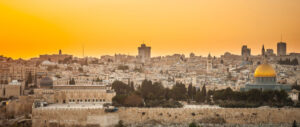

The Middle East. “Mesopotamia,” as the ancient Greeks called it, literally, “the land between rivers;” the Tigris and the Euphrates. The cradle of civilization; the Fertile Crescent. Much of what enriches our lives today –art, literature, music, poetry, culture, religion, healthy nutrition, and philosophy– can trace a straight line back to the Middle East. Perhaps more than any other subject, Middle Eastern studies belongs in the curriculum of a liberal arts education.
Middle Eastern studies touches everything from the food we eat every day to the founding of familiar religions, exemplary poetry, and philosophies that shape our outlook right up through the present.
In addition to enriching us, it also reminds us that conflict is endemic to what it means to be human, and that those who are in the best position to solve the world’s most pressing conflicts can draw strength from the context of a rich liberal arts education.
Middle Eastern Studies and Food – A Society’s Testament to Survival and Expression of Culture
 Food is fundamental to survival, and its associated rituals are a foundational part of cultural studies. As civilizations began to appear along the Fertile Crescent they developed agriculture; growing numbers of people meant food cultivation and storage was of paramount importance. This is when much of the food we’re familiar with today was first cultivated, and we have the first Middle Eastern civilizations to thank for wheat, barley, rye, oats, lentils, peas and figs.
Food is fundamental to survival, and its associated rituals are a foundational part of cultural studies. As civilizations began to appear along the Fertile Crescent they developed agriculture; growing numbers of people meant food cultivation and storage was of paramount importance. This is when much of the food we’re familiar with today was first cultivated, and we have the first Middle Eastern civilizations to thank for wheat, barley, rye, oats, lentils, peas and figs.
“Food is not rational. Food is culture, habit, craving and identity.”
–Jonathan Safran Foer
Storing cereals and preserving food for long periods to hedge against droughts and bad harvests attracted rodents. That’s why around this time one of our favorite modern-day pets was first domesticated: the house cat. Along with the cat’s taming in the Middle East came the domestication of many other animals we’ve relied on for millennia for food and clothing, including sheep, goats, pigs, and cows.
Once Middle Eastern civilizations attained relative food security, they had time for pursuits beyond those required for basic survival. Things like religion, philosophy, art, and the sciences began to flourish. With foundational contributions in all these areas it’s not a stretch to say that the liberal arts ow their roots to the Middle East.
The Beginning of History in the Middle East – A Central Liberal Arts Topic
One of the most significant events that happened in our species’ history likely took place for the first time in the Middle East. The line between prehistory and history is marked by the invention of writing, which many scholars believe initially happened in Mesopotamia.
One of the first passages of the first writing already sounds like a line from a liberal arts classic:
“In those days, in those far remote times, in those nights, in those faraway nights, in those years, in those far remote years.”
Setting the stage for the Sumerian Instructions of Shuruppak, this is one of the world’s first pieces of literature. It’s told from the vantage point of a Sumer King as advice to his son aimed at instilling virtues and upholding community standards. It would go on to have an important cultural influence, not least of which was the inspiration for Judaism’s and Christianity’s Ten Commandments.
Regarded as the oldest complete work of literature, the Epic of Gilgamesh was written around 4,000 years ago on clay tablets. Likely drawing inspiration from Sumerian poems, the story has been preserved in Old Babylonian with later versions in Akkadian, Assyrian, and Hittite.
Among other notable contributions, Gilgamesh represents the first writing where a king or ruler’s power is described as not being absolute; rather it comes from consultation and compromise with others. This is theorized by some to be the planting of the seed of democracy, a value on which our society places a great deal of importance up through the present day.
Literature, novels, history and poetry –all means of human expression that are central to the study of the liberal arts, and enabling successive branches of study like religion, philosophy, and politics– are thanks to the Middle East’s invention of writing.
Poetry and Other Written Works Flourished in the Middle East
The Middle East is known for its poetry; Gilgamesh is the world’s oldest epic poem. It makes sense that what was first established by Middle Eastern cultures would come into blossom over successive centuries:
- Imru’ al-Qais – The best-known pre-Islamic Arab poet, al-Qais was a lover of wine, women, and poetry. For scholars of the Arabic language, which goes hand-in-hand with a liberal arts education in Middle Eastern studies, al-Qais’ poetry is also an excellent source of Classical Arabic grammar. His works are influential in the Middle East up to the present day.
- Avicenna – Considered a great thinker and writer during the Islamic Golden Age, in addition to seminal works in astronomy and philosophy, this Persian was such a poet that even his writings on medicine were in verse.
- Kaygusuz Abdal – A well-known Middle Ages Turkish folk poet, he was also a dervish and theologian. Living to be nearly 100 years old between the fourteenth and fifteenth centuries, he traveled extensively throughout the Middle East.
The value of beauty in the intersecting realms of physicality, thought, and language is the nest where poetry is created; a familiar environment for the liberal arts.
Can the Arts, Cultural Respect, Philosophy, History, and Religion Resolve the Conflict in the Middle East?
 Just as the Middle East has been home to some of the greatest developments in human history, it’s also seen its share of war and conflict, and the present day is certainly no exception.
Just as the Middle East has been home to some of the greatest developments in human history, it’s also seen its share of war and conflict, and the present day is certainly no exception.
Cultural and religious differences, and historical grievances have long been the justification for war, all topics that are right at home in a liberal arts curriculum.
There are no easy solutions to the conflicts in the Middle East, but it stands to reason that it will take people with the kind of global perspective that comes from an interdisciplinary liberal arts education to understand the depth and nuance of the region’s conflicts and come up with creative solutions that will bring us closer to ending them.
Philosophy and the Age of Reason in the Middle East – A Story of the Liberal Arts
 When there’s funding and the cultural mental space for the arts to thrive, philosophy and self-understanding also tend to make gains; all familiar topics for the liberal arts.
When there’s funding and the cultural mental space for the arts to thrive, philosophy and self-understanding also tend to make gains; all familiar topics for the liberal arts.
- Persia had Zoroaster, the founder of Zoroastrianism. Also known as Zarathustra, this historical and religious figure was one of the first to introduce the concept of monotheism. He also described the concept of evil in terms of philosophy rather than the supernatural, hinting at a future where reason was valued over superstition.
- The Jewish philosopher, physician, and astronomer Maimonides was probably born in present-day Spain when it was ruled by the Muslim Almoravid Empire. His philosophical writings had an enormous influence throughout the Middle East. Today in Judaism his scholarship is regarded as fundamental to Halacha. Beyond that, he bridged the gap between Aristotelian philosophy and the Bible, had a profound influence on the Christian Saint Thomas Aquinas, and was the personal physician to sultan of the Ayyubid dynasty, Saladin. Today his tomb lies in Tiberius on the Sea of Galilee in Israel.
- Machiavelli and Hegel cite him as one of the best Middle Ages philosophers while Tamerlane acknowledges the two crossed paths; that person is the fourteenth century Arab philosopher Ibn Khaldun. Regarded as the founder of the fields of economics, sociology, and historiography, his best-known work is the Muqaddimah. Having a profound influence in Egypt and on the Ottoman Empire, Ibn Khaldun’s reach extended even further to Europe and beyond.




